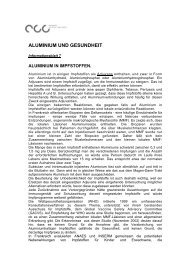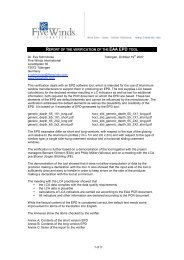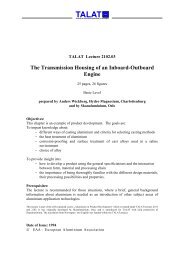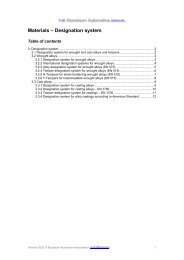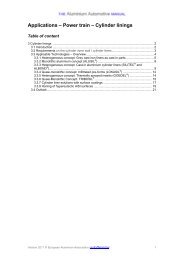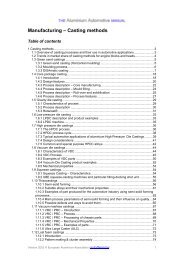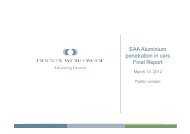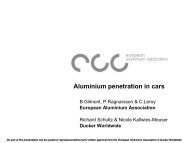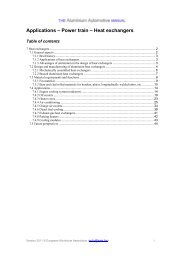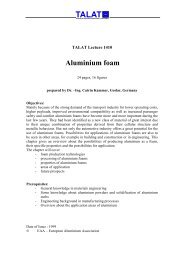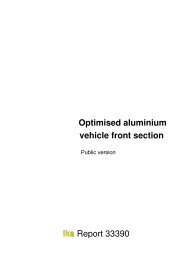Report 106310 Concept Design of a Crash Management System for ...
Report 106310 Concept Design of a Crash Management System for ...
Report 106310 Concept Design of a Crash Management System for ...
Create successful ePaper yourself
Turn your PDF publications into a flip-book with our unique Google optimized e-Paper software.
<strong>Concept</strong> <strong>Design</strong> <strong>of</strong> a <strong>Crash</strong><br />
<strong>Management</strong> <strong>System</strong> <strong>for</strong><br />
Heavy Goods Vehicles<br />
<strong>Report</strong> <strong>106310</strong>
Forschungsgesellschaft Kraftfahrwesen mbH Aachen<br />
Body Department<br />
Final <strong>Report</strong><br />
<strong>Concept</strong> <strong>Design</strong> <strong>of</strong> a <strong>Crash</strong> <strong>Management</strong> <strong>System</strong> <strong>for</strong> Heavy Goods<br />
Vehicles<br />
Project Number<br />
<strong>106310</strong><br />
Contractor:<br />
European Aluminium Association AISBL<br />
Avenue de Broqueville, 12<br />
1050 Brussels<br />
Belgium<br />
Project Leader: Project Engineer:<br />
Dipl.-Ing. Thomas Welfers<br />
Dipl.-Ing. Dipl.-Wirt. Ing. Roland Wohlecker<br />
Manager Structural Analysis and Benchmarking<br />
Univ.-Pr<strong>of</strong>. Dr.-Ing. Lutz Eckstein<br />
Chairman <strong>of</strong> the Advisory Board<br />
All rights reserved. No part <strong>of</strong> this publication may be reproduced and/or<br />
published without the previous written consent <strong>of</strong> fka. © fka<br />
Dr.-Ing. Markus Bröckerh<strong>of</strong>f<br />
Managing Director fka<br />
Aachen, June 2011<br />
Dipl.-Ing. Ralf Matheis<br />
Forschungsgesellschaft Registered in Aachen HRB 2435 Managing Director: IBAN DE 31 3907 0020 0201 339 900<br />
Kraftfahrwesen mbH Aachen Phone +49 241 8861 0 Dr.-Ing. Markus Bröckerh<strong>of</strong>f SWIFT-Code (BIC) DEUTDEDK 390<br />
Steinbachstr. 7 Fax +49 241 8861 110 Chairman <strong>of</strong> the Advisory Board: Deutsche Bank Aachen BLZ 390 700 20<br />
52074 Aachen, Germany www.fka.de Univ.-Pr<strong>of</strong>. Dr.-Ing. Lutz Eckstein Account no. 201 339 900
Contents 3<br />
Contents<br />
1 Introduction .................................................................................................................... 4<br />
2 Truck Models ................................................................................................................. 5<br />
2.1 Reference Truck ...................................................................................................... 5<br />
2.2 Advanced Truck <strong>Concept</strong> ......................................................................................... 6<br />
3 <strong>Crash</strong> <strong>Management</strong> <strong>System</strong> .......................................................................................... 8<br />
3.1 Functional Requirements ......................................................................................... 8<br />
3.2 <strong>Concept</strong> <strong>Design</strong> ..................................................................................................... 13<br />
3.3 ECE-R 93 Test ...................................................................................................... 16<br />
3.4 Simulation Load Cases .......................................................................................... 18<br />
3.4.1 Partner Protection .............................................................................................. 18<br />
3.4.2 Self Protection .................................................................................................... 20<br />
3.5 Results <strong>of</strong> <strong>Crash</strong> Simulations ................................................................................. 21<br />
3.5.1 Partner Protection .............................................................................................. 22<br />
3.5.2 Self Protection .................................................................................................... 28<br />
3.6 Weight Investigation .............................................................................................. 31<br />
4 Summary ..................................................................................................................... 32<br />
5 Literature ..................................................................................................................... 33<br />
6 Appendix ..................................................................................................................... 36<br />
6.1 Frontal Car to Truck Collision without Offset .......................................................... 36<br />
6.2 Truck to Car Rear Shunt ........................................................................................ 40
1 Introduction 4<br />
1 Introduction<br />
In the EU Directive 96/53/EC, the maximum weight and dimensions <strong>of</strong> trucks are clearly<br />
restricted. Current trucks are designed to carry a maximum <strong>of</strong> payload or a maximum volume<br />
<strong>of</strong> goods. This results in limited design flexibility regarding safety issues.<br />
A change in the regulation that allows a disconnection <strong>of</strong> the cabin length from the overall<br />
length would encourage designs that can benefit road safety. These potentials are analysed<br />
in the study “APROSYS” [APR09]. The developed truck design serves as a basis <strong>for</strong> this<br />
study and will be transferred to a 40 t truck. The focus <strong>of</strong> this study is to build up a crash<br />
management system concept that utilises the additional design space in the front <strong>of</strong> the new<br />
designed truck <strong>for</strong> optimising the energy absorption behaviour.<br />
For this purpose the reference truck as well as the advanced truck concept will be presented<br />
in the first step. Following this, functional requirements <strong>for</strong> the crash management system will<br />
be analysed. Legal requirements will be investigated and target values <strong>for</strong> crash worthiness<br />
will be defined. On this basis, a CAD model <strong>of</strong> the crash management system concept will be<br />
built up and integrated into the tractor CAD model used in the previous project. The<br />
completed design concept will be meshed with shell elements <strong>for</strong> the further simulations.<br />
The load cases that are used <strong>for</strong> the FE simulations were defined in the previous study<br />
based on HGV accident statistics. For the optimization <strong>of</strong> design parameters (e.g. geometric<br />
parameters and wall thicknesses), the two load cases “frontal car to truck with <strong>of</strong>fset” and<br />
“frontal car to truck without <strong>of</strong>fset” will be considered. The identified parameters will be<br />
applied in the finalised concept design. The per<strong>for</strong>mance <strong>of</strong> this concept will be simulated<br />
with in total four crash load cases. The load cases “truck to car rear shunt” and “truck to truck<br />
rear shunt” will be set up in addition to the existing load cases “frontal car to truck with <strong>of</strong>fset”<br />
and “frontal car to truck without <strong>of</strong>fset”. The results will be analysed, assessed and compared<br />
with the reference used <strong>for</strong> the concept.
2 Truck Models 5<br />
2 Truck Models<br />
The CAD truck model built up on the basis <strong>of</strong> the previous study “APROSYS” is introduced in<br />
this chapter. First the reference truck is presented followed by the advanced concept.<br />
2.1 Reference Truck<br />
The reference model shall represent a state <strong>of</strong> the art long haul truck. As a basis, scan points<br />
<strong>of</strong> the outer skin <strong>of</strong> a 40 t-HGV tractor are used. The cabin is a common large standard<br />
cabin. Especially the limitations <strong>of</strong> dimensions and masses result in a similar appearance <strong>of</strong><br />
the tractors from different manufacturers. Fig. 2-1 shows that only design elements like the<br />
geometry <strong>of</strong> lamps and the grille give a tractor the identity <strong>of</strong> a special brand. For that<br />
reasons these design elements are limited to functional areas in the generic reference<br />
model, so the tractor serves as a generic model.<br />
Fig. 2-1: <strong>Design</strong> elements <strong>of</strong> different manufacturers [WOL10]<br />
The trailer has a conventional design with board walls, <strong>for</strong> the reference truck as well as <strong>for</strong><br />
the optimised concept. The data <strong>for</strong> the semi-trailer are measured from a real semi-trailer.<br />
The trailer dimensions are shown in Fig. 2-2.<br />
The resulting CAD model <strong>of</strong> the reference truck is shown in Fig. 2-3. This truck is used as a<br />
basis <strong>for</strong> the evaluation <strong>of</strong> the advanced concept.
2 Truck Models 6<br />
Fig. 2-2: Dimensions <strong>of</strong> a standard semi-trailer [SCB10]<br />
Fig. 2-3: Reference truck<br />
2.2 Advanced Truck <strong>Concept</strong><br />
The advanced truck concept is shown in Fig. 2-4. It is based on the design elaborated in the<br />
“APROSYS” study. This design provides advantages regarding accidents with vulnerable<br />
road users (VRU). It has a deflective effect and can reduce the risk <strong>of</strong> overrunning VRUs in<br />
case <strong>of</strong> a frontal accident [APR09]. These aspects are not further investigated in this study.
2 Truck Models 7<br />
Fig. 2-4: Advanced concept<br />
To assure feasibility, legal requirements are also considered in the design <strong>of</strong> the advanced<br />
concept (e.g. 97/27/EC manoeuvrability, 92/144/EEC lateral projections, ECE-R 12 pendulum<br />
test, ECE-R 73 lateral protection device). The bottom view shown in Fig. 2-5 reveals<br />
the additional design space affected by the length extension <strong>of</strong> the truck front.<br />
Fig. 2-5: Additional design space<br />
Rounded front shape<br />
960 mm
3 <strong>Crash</strong> <strong>Management</strong> <strong>System</strong> 8<br />
3 <strong>Crash</strong> <strong>Management</strong> <strong>System</strong><br />
The additional design space in the front area provided by the advanced concept can be used<br />
to achieve an improvement <strong>of</strong> the safety concept by adding an additional crash management<br />
system. The build up <strong>of</strong> the crash management system is described in this chapter.<br />
3.1 Functional Requirements<br />
The crash management system should improve the energy absorption behaviour and also<br />
serve as an underrun protection system <strong>for</strong> passenger cars. Underrun protection systems<br />
have to fulfil the requirements governed by ECE-R 93. Important measurements and<br />
requirements <strong>of</strong> FUPD (Front Underrun Protection Device) are shown in Fig. 3-1.<br />
Furthermore the regulation prescribes test <strong>for</strong>ces which have to be applied to the given test<br />
points.<br />
Points P<br />
Max. 400 mm<br />
after test<br />
After test<br />
Side view Plan view<br />
Max. 450 mm<br />
after test<br />
Max. 445 mm<br />
as installed<br />
Maximum<br />
guard width<br />
Fig. 3-1: Front underrun protection device [ECE00, DAF10]<br />
To define crash worthiness target values, common crash test evaluation procedures are<br />
analysed. Additionally, target values from other projects are investigated. The crashworthiness<br />
target values are referred to a passenger car, because the accident severity will<br />
be much heavier <strong>for</strong> car occupants than <strong>for</strong> the truck occupants in case <strong>of</strong> a car to truck<br />
crash. However, such values cannot be found <strong>for</strong> the development <strong>of</strong> a truck crash<br />
management system in the executed literature research. For that reason, limiting values <strong>for</strong><br />
common car crash tests are investigated, because they are defined according to the physical<br />
limits <strong>of</strong> the human body. Fig. 3-2 shows the Euro NCAP crash test setup. A dummy is used<br />
<strong>for</strong> the evaluation <strong>of</strong> this crash. The evaluation points on this dummy are displayed in<br />
Fig. 3-3.<br />
200<br />
Vehicle front<br />
P1<br />
100<br />
700-1200<br />
P2 P3 P2<br />
Mudguard<br />
Minimum<br />
guard width
3 <strong>Crash</strong> <strong>Management</strong> <strong>System</strong> 9<br />
1000 mm<br />
540 mm<br />
64 km/h<br />
Fig. 3-2: Setup <strong>of</strong> Euro NCAP crash test [CAR11]<br />
Fig. 3-3: Evaluation points on a dummy [CAR11]<br />
40 % overlap = 40 % <strong>of</strong> the width <strong>of</strong> the widest<br />
part <strong>of</strong> the car (not including wing mirrors)<br />
Head: acceleration and HIC<br />
(Head Impact Criterion)<br />
Neck: <strong>for</strong>ces<br />
Thorax: depression<br />
Upper leg: <strong>for</strong>ces<br />
Knee: displacement<br />
Lower leg: <strong>for</strong>ces<br />
Foot: displacement (brake pedal)<br />
The recorded values on the dummy also depend on restraining system like seat belts and<br />
airbags. These influences should be investigated separately in connection with the<br />
development <strong>of</strong> car safety systems and are not considered <strong>for</strong> the design <strong>of</strong> a truck crash<br />
management system. Hence the limiting values from Euro NCAP cannot be used and so, the<br />
car related values are required.<br />
Such car related values are used in the ULSAB Project. They are listed in Fig. 3-4. Only<br />
intrusions and displacements are considered in these values. For a complete evaluation <strong>of</strong><br />
the accident severity, the occurring accelerations also need to be considered.
3 <strong>Crash</strong> <strong>Management</strong> <strong>System</strong> 10<br />
<strong>Crash</strong> Event <strong>Crash</strong>worthiness Targets<br />
US NCAP Front Impact<br />
Fig. 3-4: <strong>Crash</strong>worthiness targets <strong>of</strong> ULSAB [ULS98]<br />
Overall dynamic de<strong>for</strong>mation ≤ 650 mm<br />
Steering column displacement ≤ 80 mm in<br />
X-direction<br />
<strong>Crash</strong> Event <strong>Crash</strong>worthiness Targets<br />
Euro NCAP A-pillar displacement < 650 mm<br />
Footwell intrusion < 80 mm<br />
Steering column displacement ≤ 80 mm in<br />
X-direction<br />
The target values <strong>for</strong> intrusion are also used in the SLC project. Furthermore, maximum<br />
accelerations are also considered. For this reason, accelerations are recorded at the lower<br />
end <strong>of</strong> both B-pillars and at the middle tunnel. The decisive value is the average <strong>of</strong> these<br />
accelerations. Fig. 3-5 shows the SLC target values. Adverse in the present case is that the<br />
simulation model and the evaluation <strong>of</strong> the simulation respectively have a high degree <strong>of</strong><br />
complexity. To reduce this complexity, the intrusions into the car’s firewall and the<br />
accelerations at the rear seat only are used <strong>for</strong> the evaluation <strong>of</strong> the simulation results.<br />
A Euro NCAP crash is also simulated in this project as shown in Fig. 3-6. The according<br />
intrusions and accelerations can be seen in Fig. 3-7 and Fig. 3-8 respectively. Fig. 3-9 shows<br />
the energy absorption behaviour. The values are not suitable as a basis <strong>for</strong> comparison with<br />
a car to truck crash, because the energy absorption behaviour is different due to the<br />
differences in the crash scenario. However, at least the crash per<strong>for</strong>mance <strong>of</strong> the used car<br />
model can be evaluated this way.<br />
The car model used <strong>for</strong> the simulations is a public model <strong>of</strong> a Ford Taurus, model year 2001<br />
[NAC10]. The results show that the crash per<strong>for</strong>mance <strong>of</strong> this car cannot be compared to the<br />
per<strong>for</strong>mance <strong>of</strong> today’s vehicles, but since a comparison between two different design stages<br />
<strong>of</strong> an accident partner (in this case the truck) is required in this study, it is sufficient to use<br />
this public model.
3 <strong>Crash</strong> <strong>Management</strong> <strong>System</strong> 11<br />
Peak Intrusion Depth (mm)<br />
POINT TARGET SLC<br />
Footwell � < 100 53<br />
Footwell � < 100 51<br />
Footwell � < 100 42<br />
Wheelhouse � < 100 43<br />
Footrest � < 100 35<br />
Shaft hole � < 100 49<br />
A-plr ave < 20 19<br />
Shocktower < 100 84<br />
Steering < 100 16<br />
Door gap --- 20<br />
Pulse amax ≤ 55 g 56 g<br />
Seat torsion < 80 40 5 1 2 3<br />
Fig. 3-5: Target values defined in SLC development [BER09]<br />
Fig. 3-6: Euro NCAP <strong>of</strong>fset crash simulation<br />
Reference<br />
SLC<br />
4<br />
6
3 <strong>Crash</strong> <strong>Management</strong> <strong>System</strong> 12<br />
Fig. 3-7: Intrusions into the car’s firewall after the Euro NCAP <strong>of</strong>fset crash<br />
Acceleration [g]<br />
200<br />
175<br />
150<br />
125<br />
100<br />
75<br />
50<br />
25<br />
0<br />
Max = 370 mm<br />
Intrusion<br />
[mm]<br />
200<br />
150<br />
100<br />
50<br />
0<br />
Rear seat left side<br />
Rear seat right side<br />
0 20 40 60 80 100 120 140 160<br />
Time [ms]<br />
Fig. 3-8: Acceleration at the car’s rear seats during the Euro NCAP <strong>of</strong>fset crash
3 <strong>Crash</strong> <strong>Management</strong> <strong>System</strong> 13<br />
Energy [kJ]<br />
200<br />
160<br />
120<br />
80<br />
40<br />
0 0 20 40 60 80 100 120 140 160<br />
Fig. 3-9: Energy absorption behaviour in Euro NCAP <strong>of</strong>fset crash<br />
3.2 <strong>Concept</strong> <strong>Design</strong><br />
Time [ms]<br />
Compared to mild steel, extrusion-based aluminium bumper systems <strong>of</strong>fer approximately 45-<br />
50 % weight saving with similar or better crash per<strong>for</strong>mance [WEL06]. But aluminium crash<br />
management systems also compare very well with crash management systems made using<br />
modern high strength steel grades because <strong>of</strong> the significantly higher specific energy<br />
absorption capacity <strong>of</strong> aluminium alloys specifically developed <strong>for</strong> optimum crash<br />
per<strong>for</strong>mance.<br />
For this reason, aluminium is widely used <strong>for</strong> crash structures in passenger cars. The<br />
application <strong>of</strong> extruded crash bumpers with crash boxes is a common way to realise such<br />
systems. Fig. 3-10 shows an example. These systems are characterised by their high<br />
effectiveness and low complexity.<br />
Fig. 3-10: Extruded bumper beam with crash boxes [GIL04]<br />
Total amount<br />
<strong>of</strong> absorbed<br />
energy<br />
Energy<br />
absorbed<br />
by car<br />
Energy<br />
absorbed<br />
by barrier<br />
To further increase the effectiveness <strong>of</strong> crash management systems honeycomb structures<br />
as shown in Fig. 3-11 can be used. The energy absorption potential <strong>of</strong> these structures is<br />
higher than that <strong>of</strong> simple extrusion pr<strong>of</strong>iles. The disadvantages regarding the manufacturing<br />
and joining complexity, however, avoid a higher market penetration <strong>of</strong> this technology.
3 <strong>Crash</strong> <strong>Management</strong> <strong>System</strong> 14<br />
Fig. 3-11: Honeycomb structures <strong>for</strong> crash modules<br />
Furthermore, an unconventional approach is considered. To improve the crash per<strong>for</strong>mance<br />
<strong>of</strong> trains transversally mounted structures are currently developed. For example, the<br />
“safetram” system is shown in Fig. 3-12. An advantage <strong>of</strong> this system is that it can face<br />
multiple accident scenarios. Here, it is designed to dampen a head-on shock at 20 km/h with<br />
an identical tramway weighing 35 t or a 45°-collisi on at 25 km/h with a light commercial<br />
vehicle (3 t) [GIL04]. However, the energy absorption potential <strong>of</strong> transversally mounted<br />
pr<strong>of</strong>iles is relatively low due to the buckling behaviour. This also leads to a high system<br />
weight compared to the other solutions.<br />
Fig. 3-12: “Safetram” system <strong>for</strong> trains [GIL04]<br />
The properties <strong>of</strong> the three discussed concepts are abstracted in Fig. 3-13. The concept with<br />
extruded bumper beams and crash boxes show good per<strong>for</strong>mance and is also a well known<br />
technology. Hence it is selected <strong>for</strong> the first approach.<br />
Extruded beams<br />
with crash boxes<br />
Safetram crash<br />
module<br />
Honeycomb<br />
structures<br />
Effectiveness + o +<br />
Manufacturing<br />
complexity<br />
+ + o<br />
Complexity <strong>of</strong> joining + + -<br />
-: moderate o: neutral +: good<br />
Fig. 3-13: Assessment <strong>of</strong> possible crash management systems
3 <strong>Crash</strong> <strong>Management</strong> <strong>System</strong> 15<br />
To assign the optimal structural shape <strong>for</strong> the crash management system, a topology<br />
optimisation <strong>of</strong> the free space is executed. The principle <strong>of</strong> the topology optimisation is<br />
shown in Fig. 3-14.<br />
Fig. 3-14: Topology optimisation <strong>of</strong> free design space<br />
The results <strong>of</strong> the topology optimisation are interpreted as illustrated in Fig. 3-15. The upper<br />
crash bumper improves the self protection per<strong>for</strong>mance. The lower bumper serves as an<br />
underrun protection device. Regarding the crash boxes aluminium extrusion pr<strong>of</strong>iles with<br />
different cross sections are considered. While rectangular pr<strong>of</strong>iles show a good buckling<br />
behaviour and <strong>of</strong>fer many opportunities to connect these pr<strong>of</strong>iles to other parts <strong>of</strong> the body<br />
construction, their capability to absorb energy is just average. In contrast to rectangular<br />
pr<strong>of</strong>iles, cylindrical pr<strong>of</strong>iles provide the best possibilities to absorb energy, but they show<br />
disadvantages in buckling behaviour. Furthermore they may cause problems due to their<br />
diminished fixing capability. A good solution <strong>for</strong> this conflict is the use <strong>of</strong> octagonal pr<strong>of</strong>iles.<br />
They provide a high de<strong>for</strong>mation <strong>for</strong>ce, show a good buckling behaviour and <strong>of</strong>fer enough<br />
assembling possibilities [ADA95]. The lateral support beams (red coloured) are necessary to<br />
fulfil the ECE-R 93 requirements. To avoid redundancy <strong>of</strong> bumper systems, the original steel<br />
bumper is omitted.<br />
Self<br />
protection<br />
Model <strong>of</strong> free<br />
design space<br />
Front underrun<br />
protection<br />
Applied<br />
load<br />
Rein<strong>for</strong>cement <strong>for</strong><br />
ECE-approval<br />
Fig. 3-15: Aluminium crash management system<br />
Optimised topology<br />
<strong>for</strong> crash structure<br />
Aluminium<br />
crash boxes
3 <strong>Crash</strong> <strong>Management</strong> <strong>System</strong> 16<br />
A detailed view <strong>of</strong> the crash management system with its dimensions is shown in Fig. 3-16.<br />
To achieve a maximum <strong>of</strong> energy absorption the crash box shall buckle instead <strong>of</strong> bend. The<br />
buckling process is initialised by the initialisation crimps. The wall thickness <strong>of</strong> the lower<br />
octagon pr<strong>of</strong>iles is 2.2 mm. This thickness is defined in a parameter optimisation <strong>for</strong> the car<br />
to truck crash. This way it is ensured that the full length <strong>of</strong> the crashboxes is used <strong>for</strong> energy<br />
absorption at the lowest possible acceleration level in the car. The upper crashboxes have a<br />
wall thickness <strong>of</strong> 3 mm, because they must be designed in a more robust way to meet the<br />
self protection requirements. Also the bumpers have a wall thickness <strong>of</strong> 3 mm to provide a<br />
high level <strong>of</strong> bending stiffness, which enables good distribution <strong>of</strong> the crash loads on both<br />
attached crashboxes. The feasibility <strong>of</strong> the bending radius <strong>of</strong> the lower bumper is verified by<br />
an estimation according to [OST07].<br />
200 mm<br />
120 mm<br />
Fig. 3-16: Detailed view <strong>of</strong> the crash management system<br />
3.3 ECE-R 93 Test<br />
To check the requirements governed by ECE-R 93 the simulation model shown in Fig. 3-17<br />
is built up.<br />
280 mm<br />
Initialisation crimps<br />
190 mm
3 <strong>Crash</strong> <strong>Management</strong> <strong>System</strong> 17<br />
Fig. 3-17: Test configuration (ECE-R 93)<br />
The defined <strong>for</strong>ces are applied on the prescribed test points. The <strong>for</strong>ce courses are shown in<br />
Fig. 3-18. The red curves represent the <strong>for</strong>ce course on the left hand side and the blue ones<br />
those on the right hand side. The left graph shows the <strong>for</strong>ce curves <strong>for</strong> the outer test point<br />
and the right graph shows the same <strong>for</strong> the inner test points. The fact that the <strong>for</strong>ce level is at<br />
the required <strong>for</strong>ce level during the prescribed time period shows that the underrun protection<br />
device is able to withstand the defined <strong>for</strong>ces.<br />
80<br />
60<br />
40<br />
Force [kN] 100<br />
20<br />
0<br />
Left side<br />
Right side<br />
0 100 200 300 400 500 600 700<br />
0<br />
0 100 200 300 400 500 600 700<br />
Time [ms]<br />
Fig. 3-18: Force levels in ECE-R 93 test<br />
200<br />
150<br />
100<br />
50<br />
Left side<br />
Right side
3 <strong>Crash</strong> <strong>Management</strong> <strong>System</strong> 18<br />
3.4 Simulation Load Cases<br />
The simulation load cases are described in this subchapter. There are three setups <strong>for</strong> the<br />
evaluation <strong>of</strong> the partner protection per<strong>for</strong>mance (car occupant protection) and one <strong>for</strong> the<br />
evaluation <strong>of</strong> the self protection per<strong>for</strong>mance. All load case definitions are based on<br />
statistical findings from the previous study. Wherever possible, real crash test setups are<br />
also compared with the simulations setups.<br />
3.4.1 Partner Protection<br />
The statistical findings from the previous work show that the biggest percentages <strong>of</strong> car to<br />
truck accidents can be covered with simulation configurations representing a frontal crash<br />
and a rear shunt. In frontal accidents an <strong>of</strong>fset between the car and the truck <strong>of</strong>ten occurs,<br />
because the two accident opponents are approaching on different sides <strong>of</strong> the road. Hence<br />
two simulation setups are considered <strong>for</strong> the front crash - one without <strong>of</strong>fset and one with an<br />
<strong>of</strong>fset <strong>of</strong> 30 %. The simulation setup <strong>for</strong> the <strong>of</strong>fset crash can be seen in Fig. 3-19 and<br />
Fig. 3-20.<br />
Fig. 3-19: Simulation configuration in top view<br />
Fig. 3-20: Simulation configuration in isometric view<br />
The frontal collision setup with 30 % <strong>of</strong>fset is also used by DEKRA to evaluate the partner<br />
protection per<strong>for</strong>mance <strong>of</strong> trucks as shown in Fig. 3-21. In this car crash test configuration<br />
the truck has a velocity <strong>of</strong> 21 km/h. The passenger car’s speed is 42 km/h [DEK10]. These<br />
velocity values represent a typical intra-urban accident scenario. Hence the same values are<br />
used <strong>for</strong> the simulation setup.
3 <strong>Crash</strong> <strong>Management</strong> <strong>System</strong> 19<br />
<strong>Crash</strong> configuration Truck after crash Car after crash<br />
Fig. 3-21: DEKRA truck against car crash test [DEK10]<br />
<strong>Crash</strong> tests with a similar configuration are also executed by truck manufacturers. Volvo, <strong>for</strong><br />
example completes a crash test illustrated in Fig. 3-22 to develop the Front Underride<br />
Protection <strong>System</strong> (FUPS). The truck has a velocity <strong>of</strong> 65 km/h and hits the car with 50 %<br />
<strong>of</strong>fset. The target <strong>of</strong> this crash test is to identify the crash per<strong>for</strong>mance <strong>of</strong> the tractor using a<br />
FUPS [VOL10c].<br />
<strong>Crash</strong> configuration <strong>Crash</strong> test Truck after crash<br />
Fig. 3-22: Volvo truck against car crash test [SCH06]<br />
In addition this crash test is completed with different velocities <strong>of</strong> the car (56 km/h, 64 km/h<br />
and 75 km/h) and with different kinds <strong>of</strong> cars (super mini and small family). This way it is<br />
possible to design the FUPS <strong>for</strong> different crash severities [VOL10c]. Further in<strong>for</strong>mation<br />
about the FUPS can be found in [UTA05].<br />
Impact <strong>for</strong>ce<br />
Large car<br />
Medium car<br />
Small car<br />
Fig. 3-23: Results <strong>of</strong> Volvo crash test [VOL10c]<br />
Volvo FUPS<br />
maximum <strong>for</strong>ce<br />
Volvo FUPS trigging <strong>for</strong>ce<br />
Time
3 <strong>Crash</strong> <strong>Management</strong> <strong>System</strong> 20<br />
The setup that represents a frontal car to truck accident without <strong>of</strong>fset and the truck to car<br />
rear shunt setup is shown in Fig. 3-24. In the frontal the same collision velocities are used as<br />
in the setup with <strong>of</strong>fset. To represent a typical accident scenario in the truck to car rear shunt<br />
setup the car’s velocity is set to 0 km/h and the speed <strong>of</strong> the truck is 20 km/h.<br />
Fig. 3-24: Frontal car to truck without <strong>of</strong>fset and truck to car rear shunt<br />
3.4.2 Self Protection<br />
For the evaluation <strong>of</strong> the self protection per<strong>for</strong>mance one setup is defined. The most relevant<br />
scenario is a truck hitting the trailer <strong>of</strong> another truck. This configuration is also used by truck<br />
manufacturers. A crash test executed by MAN is shown in Fig. 3-25. The truck hits a barrier<br />
with a velocity <strong>of</strong> 30 km/h and at an <strong>of</strong>fset <strong>of</strong> 50 % between truck and barrier. The de<strong>for</strong>mable<br />
barrier has a weight <strong>of</strong> 20 t. The goal is to identify the intrusion and the energy absorption<br />
behaviour <strong>of</strong> the tractor’s structure. Additionally the evacuation behaviour to rescue the driver<br />
is evaluated. Especially the cabin is tested with this crash configuration.<br />
l De<strong>for</strong>med structure in FE simulation<br />
Fig. 3-25: <strong>Crash</strong> configuration by MAN [BAC09]<br />
door structure<br />
cabin support<br />
longitudinal<br />
beam
3 <strong>Crash</strong> <strong>Management</strong> <strong>System</strong> 21<br />
Volvo is completing similar crash tests against an 850 t heavy steel block barrier with an<br />
angle <strong>of</strong> 30°. This configuration can be seen in Fig . 3-26. The truck has a velocity <strong>of</strong> 30 km/h.<br />
This test corresponds to a 50 km/h crash into the rear <strong>of</strong> a trailer. Again the goal is to identify<br />
the energy absorption, cabin strength, cabin attachment and the evacuation behaviour <strong>of</strong> the<br />
cabin structure. In addition occupant injuries are evaluated [VTN09].<br />
Side view Top view<br />
Fig. 3-26: <strong>Crash</strong> configuration by Volvo [VTN09]<br />
For the FE simulations <strong>of</strong> the self-protection tests in this study, the tractor hits a semi-trailer<br />
with a velocity <strong>of</strong> 30 km/h and at an <strong>of</strong>fset <strong>of</strong> 50 % between truck and the trailer. The crash<br />
per<strong>for</strong>mance is evaluated by analysis <strong>of</strong> the intrusions and the energy absorption behaviour.<br />
The FE model configuration used <strong>for</strong> the simulations can be seen in Fig. 3-27.<br />
Fig. 3-27: Simulation configuration in isometric view<br />
3.5 Results <strong>of</strong> <strong>Crash</strong> Simulations<br />
The results <strong>of</strong> the crash simulations are presented in the following.
3 <strong>Crash</strong> <strong>Management</strong> <strong>System</strong> 22<br />
3.5.1 Partner Protection<br />
As an example the simulation results <strong>for</strong> the frontal collision with 30 % <strong>of</strong>fset (vtruck = 21 km/h,<br />
vcar = 42 km/h) are investigated. The recorded data <strong>for</strong> all other car to truck simulations can<br />
be seen in subchapters 6.1 and 6.2 <strong>of</strong> the appendix.<br />
Fig. 3-28: Simulation results<br />
Reference truck Advanced concept
3 <strong>Crash</strong> <strong>Management</strong> <strong>System</strong> 23<br />
The comparison <strong>of</strong> the simulation results <strong>of</strong> the reference truck and the advanced concept<br />
are shown in Fig. 3-28. The evaluation <strong>of</strong> the intrusions and the occurring accelerations show<br />
differences in the crash behaviour. These data are illustrated in Fig. 3-29, Fig. 3-30 and<br />
Fig. 3-31.<br />
Reference truck Advanced concept<br />
Max = 186.1 mm Max = 174.4 mm<br />
Fig. 3-29: Intrusions into the car’s firewall after the crash<br />
The maximum intrusion into the car’s firewall after the crash with the reference truck is<br />
186.1 mm. After the crash with the advanced concept the peak value is 174.4 mm.<br />
Furthermore the advanced concept shows reduced intrusion values in the steering wheel<br />
area. This area is critical, because intrusions here are likely to cause contact between the<br />
occupant parts <strong>of</strong> the car which increases the risk <strong>of</strong> injuries.<br />
Acceleration [g]<br />
100<br />
80<br />
60<br />
40<br />
20<br />
0<br />
Fig. 3-30: Acceleration at the car’s rear seats during crash with reference truck<br />
Intrusion<br />
[mm]<br />
180<br />
140<br />
100<br />
60<br />
20<br />
0<br />
Rear seat left side<br />
Rear seat right side<br />
0 20 40 60 80<br />
Time [ms]<br />
100 120 140 160
3 <strong>Crash</strong> <strong>Management</strong> <strong>System</strong> 24<br />
Acceleration [g]<br />
100<br />
80<br />
60<br />
40<br />
20<br />
0<br />
0 20 40 60 80 100 120 140 160<br />
Time [ms]<br />
Fig. 3-31: Acceleration at the car’s rear seats during crash with the advanced concept<br />
Analysing the accelerations it becomes conspicuous that the application <strong>of</strong> the crash<br />
management system leads to a reduced peak value below 70 g (compared to 85 g <strong>for</strong> the<br />
reference truck). In conclusion, the partner protection per<strong>for</strong>mance is enhanced.<br />
To evaluate the trucks behaviour during the crash the <strong>for</strong>ces inside the side members are<br />
investigated. Fig. 3-32 shows the evaluation points <strong>for</strong> the recording <strong>of</strong> the occurring <strong>for</strong>ces.<br />
The results are shown in Fig. 3-33 and Fig. 3-34.<br />
1: Left side<br />
member front<br />
3: Right side<br />
member front<br />
2: Left side<br />
member rear<br />
4: Right side<br />
member rear<br />
Fig. 3-32: Evaluation points <strong>for</strong> occurring <strong>for</strong>ces<br />
Rear seat left side<br />
Rear seat right side
3 <strong>Crash</strong> <strong>Management</strong> <strong>System</strong> 25<br />
Force [kN]<br />
0 20 40 60 80 100 120 140 160<br />
Time [ms]<br />
Fig. 3-33: Forces in the side members <strong>of</strong> the reference truck during the crash<br />
Force [kN]<br />
400<br />
350<br />
300<br />
250<br />
200<br />
150<br />
100<br />
50<br />
0<br />
400<br />
350<br />
300<br />
250<br />
200<br />
150<br />
100<br />
50<br />
0<br />
0 20 40 60 80 100 120 140 160<br />
Time [ms]<br />
Fig. 3-34: Forces in the side members <strong>of</strong> the advanced concept during the crash<br />
The evaluation <strong>of</strong> the <strong>for</strong>ces in the side members <strong>of</strong> the truck shows that the <strong>for</strong>ces are<br />
reduced. This way the self protection per<strong>for</strong>mance is improved.<br />
To further clarify the positive effects <strong>of</strong> the crash management system, different amounts <strong>of</strong><br />
absorbed energy are shown in Fig. 3-35 and Fig. 3-36. It can be seen that in both cases, the<br />
total amount <strong>of</strong> absorbed energy is same. But comparing the reference truck with the<br />
1<br />
2<br />
1<br />
2<br />
3<br />
4<br />
3<br />
4
3 <strong>Crash</strong> <strong>Management</strong> <strong>System</strong> 26<br />
advanced concept, it becomes obvious that the proportion <strong>of</strong> energy absorbed by the car can<br />
be reduced from 130 kJ to 112 kJ. Another advantage <strong>of</strong> the advanced concept is the longer<br />
span <strong>of</strong> time in which energy can be absorbed. In case <strong>of</strong> the reference truck, all the energy<br />
is absorbed in 100 ms while the advanced concept uses 130 ms <strong>for</strong> energy absorption.<br />
Energy [kJ]<br />
225 Total amount<br />
200<br />
<strong>of</strong> absorbed<br />
energy<br />
175<br />
Energy<br />
150<br />
absorbed<br />
125<br />
by car<br />
100<br />
75<br />
Energy<br />
absorbed<br />
by truck<br />
50<br />
25<br />
0<br />
0 20 40 60 80 100 120 140 160<br />
Time [ms]<br />
Fig. 3-35: Energy absorption behaviour <strong>of</strong> reference truck (The truck absorbs ~62.5 kJ)<br />
Energy [kJ]<br />
225 Total amount<br />
200<br />
<strong>of</strong> absorbed<br />
energy<br />
175<br />
Energy<br />
150<br />
absorbed<br />
125<br />
by car<br />
100<br />
75<br />
Energy<br />
absorbed<br />
by truck<br />
50<br />
25<br />
0<br />
0 20 40 60 80 100 120 140 160<br />
Time [ms]<br />
Fig. 3-36: Energy absorption behaviour <strong>of</strong> advanced concept (The truck absorbs ~85 kJ)<br />
In Fig. 3-37, Fig. 3-38 and Fig. 3-39 the maximum values <strong>of</strong> all partner protection simulations<br />
are contrasted. All according figures can be seen in the subchapters 6.1 and 6.2 <strong>of</strong> the<br />
appendix. It can be seen that except <strong>for</strong> one value all values have improved. So a mitigation<br />
<strong>of</strong> the accident severity can be assumed <strong>for</strong> these cases. A more detailed investigation <strong>of</strong> the<br />
intrusion in the frontal crash without <strong>of</strong>fset is illustrated in Fig. 3-39. It reveals that the
3 <strong>Crash</strong> <strong>Management</strong> <strong>System</strong> 27<br />
maximum value <strong>of</strong> intrusion only occurs in a small area on the upper right side. The<br />
intrusions in the critical steering wheel area and the rest <strong>of</strong> the firewall, however, are<br />
reduced.<br />
Frontal crash with <strong>of</strong>fset Reference truck Advanced concept<br />
max. intrusions into the car’s<br />
firewall [mm]<br />
max. acceleration at the rear<br />
seat <strong>of</strong> the car [g]<br />
max. <strong>for</strong>ce in side members<br />
<strong>of</strong> the truck [kN]<br />
186.1 174.4<br />
85 70<br />
305 240<br />
Fig. 3-37: Comparison <strong>of</strong> maximum values <strong>for</strong> frontal crash with 30 % <strong>of</strong>fset<br />
Frontal crash without <strong>of</strong>fset Reference truck Advanced concept<br />
max. intrusions into the car’s<br />
firewall [mm]<br />
max. acceleration at the rear<br />
seat <strong>of</strong> the car [g]<br />
max. <strong>for</strong>ce in side members<br />
<strong>of</strong> the truck [kN]<br />
175.9 187.3<br />
250 112.5<br />
427 235<br />
Fig. 3-38: Comparison <strong>of</strong> maximum values <strong>for</strong> frontal crash without <strong>of</strong>fset<br />
Reference truck Advanced concept<br />
Max = 175.9 mm Max = 187.3 mm<br />
Fig. 3-39: Intrusions into the car’s firewall after frontal crash without <strong>of</strong>fset<br />
Rear shunt Reference truck Advanced concept<br />
max. intrusions into the car’s<br />
rear floor panel [mm]<br />
max. acceleration at the rear<br />
seat <strong>of</strong> the car [g]<br />
max. <strong>for</strong>ce in side members<br />
<strong>of</strong> the truck [kN]<br />
-80.2 -34.8<br />
170 59<br />
90 74<br />
Fig. 3-40: Comparison <strong>of</strong> maximum values <strong>for</strong> truck to car rear shunt<br />
Intrusion<br />
[mm]<br />
180<br />
140<br />
100<br />
60<br />
20<br />
0
3 <strong>Crash</strong> <strong>Management</strong> <strong>System</strong> 28<br />
3.5.2 Self Protection<br />
The result <strong>of</strong> the simulation <strong>of</strong> the truck to truck rear shunt scenario (vtruck = 30 km/h, vtrailer =<br />
0 km/h, 50 % <strong>of</strong>fset) is shown in Fig. 3-41. The comparison <strong>of</strong> the simulation results shows<br />
that the self protection per<strong>for</strong>mance <strong>of</strong> the advanced concept is already improved. The<br />
advanced concept absorbs more crash energy in the front part <strong>of</strong> the cabin. This becomes<br />
more evident when the intrusions into the front <strong>of</strong> the truck and the front lateral beam are<br />
evaluated. These are shown in Fig. 3-42 and Fig. 3-43.<br />
Fig. 3-41: Simulation results<br />
Reference truck Advanced concept<br />
The evaluation <strong>of</strong> the intrusions into the tractor front reveals that both the maximum value<br />
and the average values are lower at the advanced concept’s front. Hence, it follows that the<br />
survival space <strong>for</strong> the driver is larger and also the evacuation behaviour to rescue the driver
3 <strong>Crash</strong> <strong>Management</strong> <strong>System</strong> 29<br />
is improved. The curves <strong>of</strong> occurring <strong>for</strong>ces in the side members during the crash are shown<br />
in Fig. 3-44 and Fig. 3-45.<br />
Reference truck Advanced concept<br />
Max = 373.1 mm<br />
Fig. 3-42: Intrusion into front<br />
Fig. 3-43: Intrusion into the front lateral beam<br />
Max = 351.5 mm<br />
Reference truck Advanced concept<br />
Max = 148.8 mm<br />
Max = 59.1 mm<br />
Intrusion<br />
[mm]<br />
All curves show lower peak values, which leads to a reduction <strong>of</strong> the accident severity. The<br />
evaluation <strong>of</strong> the occurring <strong>for</strong>ces show an improvement <strong>of</strong> the self protection per<strong>for</strong>mance.<br />
The analysis <strong>of</strong> the simulation furthermore reveals that the optimisation potential also exists<br />
in trailer design. It can be seen in Fig. 3-46 that the upper part <strong>of</strong> the crash management<br />
system hits the rear bumper <strong>of</strong> the trailer. The mounting <strong>of</strong> the rear bumper however<br />
collapses, so the crash management is not able to absorb a sufficient amount <strong>of</strong> energy.<br />
Instead, the side member <strong>of</strong> the trailer hits the cabin and causes high intrusions. This<br />
behaviour can be improved by alternative trailer concepts to mitigate accident consequences<br />
in this scenario.<br />
400<br />
300<br />
200<br />
100<br />
0<br />
Intrusion<br />
[mm]<br />
200<br />
150<br />
100<br />
50<br />
0
3 <strong>Crash</strong> <strong>Management</strong> <strong>System</strong> 30<br />
Force [kN]<br />
300<br />
200<br />
100<br />
0<br />
0 20 40 60 80 100 120 140 160 180 200 220<br />
Time [ms]<br />
Fig. 3-44: Forces in the side members <strong>of</strong> the reference tractor during the crash<br />
Force [kN]<br />
250<br />
150<br />
50<br />
300<br />
250<br />
200<br />
150<br />
100<br />
50<br />
0<br />
0 20 40 60 80 100 120 140 160 180 200 220<br />
Time [ms]<br />
Fig. 3-45: Forces in the side members during the crash with crash management system<br />
Fig. 3-46: Side view <strong>of</strong> crash kinematics<br />
1<br />
2<br />
1<br />
2<br />
3<br />
4<br />
3<br />
4
3 <strong>Crash</strong> <strong>Management</strong> <strong>System</strong> 31<br />
3.6 Weight Investigation<br />
The crash management system’s weight is 60.7 kg. The standard steel bumper system’s<br />
weight is 53.6 kg. Since the crash management system replaces the steel bumper system,<br />
an additional mass <strong>of</strong> 7.1 kg must be compensated. This can, <strong>for</strong> example, be easily done by<br />
using an aluminium 5 th wheel Fig. 7-2 instead <strong>of</strong> a conventional steel device. This way a<br />
mass reduction between 33 kg (37 %) to 45 kg is possible.<br />
Fig. 3-47: Aluminium 5 th wheel
4 Summary 32<br />
4 Summary<br />
The scope <strong>of</strong> this study was to develop a crash management system concept <strong>for</strong> 40 t trucks.<br />
The basis was an advanced truck concept that was developed based on the truck front<br />
design developed in the “APROSYS” study. This truck provides an extended front to improve<br />
aerodynamic properties and safety. The additional design space that is affected by the length<br />
extension was utilised in this study to apply a crash management system concept that<br />
improves the energy absorption behaviour in case <strong>of</strong> an accident.<br />
In the first part the advanced truck concept as well as the reference truck that <strong>for</strong>m the basis<br />
<strong>for</strong> the comparison <strong>of</strong> per<strong>for</strong>mances was introduced. The optimisation measures to lower the<br />
drag resistance <strong>of</strong> the optimised concept were explained briefly.<br />
For the build up <strong>of</strong> the crash management system concept, functional requirements were<br />
collected. It was found in the analysis <strong>of</strong> legal requirements that a type approval according to<br />
ECE-R 93 is necessary <strong>for</strong> the crash management system concept, because it shall also<br />
serve as an underrun protection device <strong>for</strong> passenger cars. All measures prescribed in the<br />
regulation were considered in the construction <strong>of</strong> the crash management system concept and<br />
the test procedure was simulated using an FE model. To define crashworthiness target<br />
values, other research projects with the scope <strong>of</strong> the development <strong>of</strong> crash structures were<br />
investigated. These projects use the Euro NCAP crash test as a basis <strong>for</strong> comparison <strong>for</strong><br />
newly developed structures. For this reason, an FE simulation <strong>of</strong> the Euro NCAP<br />
configuration was carried out <strong>for</strong> the used car model, so it can serve as a basis <strong>for</strong><br />
comparison.<br />
According to the elaborated requirements a concept design <strong>for</strong> the crash management<br />
system was built up. For the choice <strong>of</strong> the used material, aluminium and steel were<br />
considered. Also different basic concepts were analysed. An aluminium solution with octagon<br />
crash box pr<strong>of</strong>iles proved to be the right choice because <strong>of</strong> its high energy absorption<br />
potential, low technical complexity and its low weight.<br />
After this, a CAD model was built up. This model was meshed with shell elements and used<br />
<strong>for</strong> the crash simulations. The four load cases “frontal car to truck with <strong>of</strong>fset”, “frontal car to<br />
truck without <strong>of</strong>fset”, “truck to car rear shunt” and “truck to truck rear shunt” were considered<br />
in the simulations. In the evaluation <strong>of</strong> the simulation runs, it was found that the developed<br />
crash management system concept mitigates the accident severity in all cases.<br />
This study shows that the additional design space that would result from a length extension<br />
<strong>of</strong> the front <strong>of</strong> trucks can be efficiently utilised <strong>for</strong> application <strong>of</strong> crash management systems,<br />
which mitigate the consequences <strong>of</strong> an accident <strong>for</strong> the accident partner as well as <strong>for</strong> the<br />
truck occupants. From this point <strong>of</strong> view, in case the EU directive 96/53/EC regarding<br />
maximum dimension <strong>of</strong> trucks is reviewed, it is clearly desirable to disconnect the cabin<br />
length from the overall length <strong>of</strong> the vehicle. In this way a design that will improve road safety<br />
can be encouraged. In the continuation this can also open up possibilities to introduce<br />
minimum criteria <strong>for</strong> the energy absorption <strong>of</strong> the truck front structure.
5 Literature 33<br />
5 Literature<br />
[ADA95] ADAM, H.<br />
Untersuchung zur Optimierung der Vorhersagbarkeit der Energieabsorptionseigenschaften<br />
von Karosseriestrukturen<br />
Schriftenreihe Automobiltechnik<br />
Institut für Kraftfahrwesen Aachen, 1995<br />
[APR09] N. N.<br />
APROSYS website<br />
http://www.aprosys.com/<br />
[BAC09] BACHEM, H.; GUSERLE, S.<br />
MAN TGX/TGS – Active and Passive Safety<br />
MAN Nutzfahrzeuge AG<br />
18. Aachener Kolloquium Fahrzeug und Motorentechnik,<br />
RWTH Aachen Univsersity, Aachen, 2009<br />
[BER09] BERGER, L.; LESEMANN, M.; SAHR, C.<br />
SuperLIGHT-CAR - the Multi-Material Car Body<br />
7th European LS-DYNA Conference, Salzburg, Österreich, 2009<br />
[CAR11] N. N.<br />
SafetyCompanion 2011<br />
carhs.training gmbh, 2011<br />
[DAF10] N. N.<br />
Imagebank<br />
http://www.daftrucks.com<br />
DAF Trucks N.V., Eindhoven, 2010<br />
[DEK10] N. N.<br />
Aktuelle <strong>Crash</strong>testberichte<br />
MAN gegen VW Golf<br />
http://www.dekra.de<br />
DEKRA e.V., Stuttgart, 2010<br />
[ECE00] N. N.<br />
ECE-R 93 – Front underrun protective devices<br />
Regulations <strong>of</strong> the UN Economic Commission <strong>for</strong> Europe (ECE)<br />
http://www.unece.org<br />
UN Economic Commission <strong>for</strong> Europe, Switzerland, 2000
5 Literature 34<br />
[GIL04] GILMONT, B.<br />
Aluminium improves transport safety<br />
Texts and illustrations <strong>for</strong> the European transport press<br />
Press In<strong>for</strong>mation, European Aluminium Association, 2004<br />
[NCA10] N. N<br />
National <strong>Crash</strong> Analysis Center<br />
http://www.ncac.gwu.edu/vml/models.html<br />
[OST07] OSTERMANN, F.<br />
Anwendungstechnologie Aluminium<br />
2., neu bearbeitete und aktualisierte Auflage<br />
Springer-Verlag Berlin Heidelberg 1998, 2007<br />
[SCB10] N. N.<br />
S.CS UNIVERSAL<br />
Schmitz Cargobull AG, Horstmar, 2010<br />
[SCH06] SCHRAM, R.<br />
Car-to-Truck Testing and Simulations<br />
http://vc-compat.rtdproject.net<br />
VC-COMPAT, Eindhoven, 2006<br />
[ULS98] N. N.<br />
ULSAB Engineering Reprort<br />
6. CAE Analysis Results<br />
WorldAutoSteel<br />
www.worldautosteel.org/uploaded/2_2_6_ULSAB_EngRpt_CAEAnalRes.pdf<br />
1998<br />
[UTA05] N. N.<br />
Front underride protection / rear underride protection<br />
UTAC Gothenburg<br />
Workshop Gothenburg, Gothenburg, 2005<br />
[VOL10c] N. N.<br />
Volvo - Safety<br />
Nobody Has <strong>Crash</strong>ed<br />
http://www.volvo.com<br />
Volvo Truck Corporation, Gothenburg, 2010
5 Literature 35<br />
[VTN09] N. N.<br />
TruckNews0309<br />
Willkommen in der <strong>Crash</strong>-Fabrik<br />
http://www.volvo.com<br />
Truck News, Ismaning, 2009<br />
[WEL06] WELO, T.; et al<br />
ATZ autotechnology Edition, 2/2006<br />
[WOL10] WOLFSGRUBER, A.<br />
Nutzfahrzeugdesign im 21. Jahrhundert<br />
Szenarien, Trends und Utopien im Truckdesign<br />
MAGNA STEYR Fahrzeugtechnik<br />
4. Grazer Nfz Workshop<br />
TU Graz, Graz, 2010
6 Appendix 36<br />
6 Appendix<br />
6.1 Frontal Car to Truck Collision without Offset<br />
In this car crash test configuration the truck has a velocity <strong>of</strong> 21 km/h. The passenger car’s<br />
speed is 42 km/h.<br />
Reference truck Advanced concept<br />
Max = 175.9 mm Max = 187.3 mm<br />
Fig. 6-1: Intrusions into the car’s firewall after the crash<br />
Acceleration [g]<br />
250<br />
200<br />
150<br />
100<br />
50<br />
0<br />
Intrusion<br />
[mm]<br />
180<br />
140<br />
100<br />
60<br />
20<br />
0<br />
Rear seat left side<br />
Rear seat right side<br />
0 20 40 60 80 100 120 140 160<br />
Time [ms]<br />
Fig. 6-2: Acceleration at the car’s rear seats during the crash with the reference truck
6 Appendix 37<br />
Acceleration [g]<br />
250<br />
200<br />
150<br />
100<br />
50<br />
0<br />
0 20 40 60 80 100 120 140 160<br />
Time [ms]<br />
Fig. 6-3: Acceleration at the car’s rear seats during the crash with the advanced concept<br />
Force [kN]<br />
450<br />
400<br />
350<br />
300<br />
250<br />
200<br />
150<br />
100<br />
50<br />
0<br />
Fig. 6-4: Forces in the side members <strong>of</strong> the reference truck<br />
Rear seat left side<br />
Rear seat right side<br />
0 20 40 60 80 100 120 140 160<br />
Time [ms]<br />
1<br />
2<br />
3<br />
4
6 Appendix 38<br />
Force [kN]<br />
450<br />
1 3<br />
400<br />
2 4<br />
350<br />
300<br />
250<br />
200<br />
150<br />
100<br />
50<br />
0<br />
0 20 40 60 80 100 120 140 160<br />
Time [ms]<br />
Fig. 6-5: Forces in the side members <strong>of</strong> the advanced concept<br />
Energy [kJ]<br />
225 Total amount<br />
200<br />
<strong>of</strong> absorbed<br />
energy<br />
175<br />
Energy<br />
150<br />
absorbed<br />
125<br />
by car<br />
100<br />
75<br />
Energy<br />
absorbed<br />
by truck<br />
50<br />
25<br />
0<br />
0 20 40 60 80 100 120 140 160<br />
Time [ms]<br />
Fig. 6-6: Energy absorption behaviour <strong>of</strong> reference truck
6 Appendix 39<br />
Energy [kJ]<br />
225 Total amount<br />
200<br />
<strong>of</strong> absorbed<br />
energy<br />
175<br />
Energy<br />
150<br />
absorbed<br />
125<br />
by car<br />
100<br />
75<br />
Energy<br />
absorbed<br />
by truck<br />
50<br />
25<br />
0<br />
0 20 40 60 80 100 120 140 160<br />
Time [ms]<br />
Fig. 6-7: Energy absorption behaviour <strong>of</strong> the advanced concept
6 Appendix 40<br />
6.2 Truck to Car Rear Shunt<br />
In this car crash test configuration without <strong>of</strong>fset the truck has a velocity <strong>of</strong> 20 km/h. The<br />
passenger car’s speed is 0 km/h.<br />
Fig. 6-8: Simulation results<br />
Reference truck Advanced concept
6 Appendix 41<br />
Fig. 6-9: Intrusions into the car’s rear bottom panel<br />
Acceleration [g]<br />
200<br />
150<br />
100<br />
50<br />
0<br />
Reference truck Advanced concept<br />
Max = -80.2 mm Max = -34.8 mm<br />
Intrusion<br />
[mm]<br />
Fig. 6-10: Acceleration at the car’s rear seats during the crash with the reference truck<br />
-120<br />
-90<br />
-60<br />
-30<br />
0<br />
Rear seat left side<br />
Rear seat right side<br />
0 20 40 60 80 100 120 140 160<br />
Time [ms]
6 Appendix 42<br />
Acceleration [g]<br />
100<br />
75<br />
50<br />
25<br />
0<br />
0 20 40 60 80 100 120 140 160<br />
Time [ms]<br />
Fig. 6-11: Acceleration at the car’s rear seats during the crash with the advanced concept<br />
Force [kN]<br />
150<br />
125<br />
100<br />
75<br />
50<br />
25<br />
0<br />
Fig. 6-12: Forces in the side members <strong>of</strong> the reference truck<br />
Rear seat left side<br />
Rear seat right side<br />
0 20 40 60 80<br />
Time [ms]<br />
100 120 140 160<br />
1<br />
2<br />
3<br />
4
6 Appendix 43<br />
Force [kN]<br />
150<br />
100<br />
50<br />
0<br />
0 20 40 60 80 100 120 140 160<br />
Time [ms]<br />
Fig. 6-13: Forces in the side members <strong>of</strong> the advanced concept<br />
Energy [kJ]<br />
125<br />
75<br />
25<br />
40 Total amount<br />
35<br />
<strong>of</strong> absorbed<br />
energy<br />
30<br />
25<br />
20<br />
15<br />
10<br />
5<br />
0<br />
0 20 40 60 80 100 120 140 160<br />
Time [ms]<br />
Fig. 6-14: Energy absorption behaviour <strong>of</strong> reference truck<br />
1<br />
2<br />
3<br />
4<br />
Energy<br />
absorbed<br />
by car<br />
Energy<br />
absorbed<br />
by truck
6 Appendix 44<br />
Energy [kJ]<br />
40 Total amount<br />
35<br />
<strong>of</strong> absorbed<br />
energy<br />
30<br />
25<br />
20<br />
15<br />
10<br />
5<br />
0<br />
0 20 40 60 80 100 120 140 160<br />
Time [ms]<br />
Fig. 6-15: Energy absorption behaviour <strong>of</strong> the advanced concept<br />
Energy<br />
absorbed<br />
by car<br />
Energy<br />
absorbed<br />
by truck



